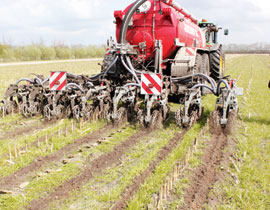Vogelsang XTill makes the most of slurry

A new approach to establishing forage maize and oilseed rape makes the best use of farm slurry, as well as minimising the amount of cultivation that has to be done. Peter Hill reports.
Two establishment techniques unfamiliar to UK forage maize growers are combined in a novel two-pass system that could cut cultivation costs as well as exploiting the nutrient value of farm slurry more effectively.
The XTill system devised by German slurry application equipment specialist Vogelsang proposes moving from overall cultivation to strip tillage, applying and incorporating slurry in a single pass, and subsequently sowing forage maize into the prepared strips of soil.
“Strip tillage makes a lot of sense for row crops – why cultivate soil between the rows when all it does is consume fuel, lose moisture and encourage weed growth?,” says Sion Williams of Vogelsang UK. “Cultivating in strips is more efficient and provides other benefits, such as a firmer surface for machines to travel on at harvest, and applying slurry at the same time combines two operations in one.”
A handful of growers have already recognised the benefits of strip tillage for maize and have equipped themselves with specialist implements for one-pass cultivation and sowing. They say reduced moisture loss and improved soil structure over time are among the benefits of the technique, together with lower cultivation costs.
UK experience
Norfolk grower Stephen Temple estimates fuel consumption alone is half that of a conventional plough-and-cultivate approach, while in Kent, Jerry Wilson reports improved soil structure and better harvesting conditions in a wet year as a result of cultivating only a third of the field surface (FWi, October 28, 2011).
Strip-tilled soils tend to take a little longer to warm up in the spring, but growers say crops soon compensate for a slight delay in sowing date, especially in a dry year when the technique is effective at retaining soil moisture.
Vogelsang’s concept is to separate the strip tilling element of this approach from sowing to ensure there’s no risk of seedling scorch. Instead it is combined with application of slurry or biogas digestate.
“These nutrient sources are best applied by dribble bar, trailing shoe or injection to minimise loss to the atmosphere, with injection clearly the most effective technique in that respect,” says Mr Williams. “So why not cultivate the soil at the same time in preparation for sowing?”
The XTill cultivating injector devised by Vogelsang is 6m wide, weighs 3t and can readily be fitted to a slurry tanker with three-point linkage. The standard rig has eight strip-tilling assemblies that are adjustable for spacing and strip width, and are carried on parallel linkage with individual pressure and depth control.
Each unit consists of a cutting disc with plastic depth-limiting structures on both sides, followed by a pair of angled star wheels to clear stubble and other crop residue to one side.
Accurate bout-marking
The injector tine placing slurry 10-25cm deep is positioned between two cultivating discs that, in addition to tilling the soil, restrict movement of soil thrown up by the injector tine. The assembly is completed by a couple of press wheels to firm the resulting tilth.
“Traditionally, fields growing maize are ploughed and cultivated before drilling, but this takes time and energy,” adds Ansgar Jansen of Vogelsang. “With XTill, we use the strip tillage concept to cultivate only the soil where the maize will grow, while providing targeted use of slurry or digestate by injecting it beneath where the plants will grow to provide some of the crop’s nutrient requirements.”
Accurate bout matching is clearly important so high-definition steering guidance using an RTK satellite system is recommended, although operators using the system elsewhere in Europe are using chain markers effectively, says Mr Jansen.
When sowing, from five or six days to six weeks later, it is also essential to steer the maize planter accurately and today’s high-speed machines will likely also call for a good GPS autosteer system.
“The injected slurry is retained within the tilled band of soil, but deep enough to avoid scorch when the maize seed germinates,” says Sion Williams. “But the roots can grow straight down towards moisture and nutrients provided by the slurry.”
Vogelsang plans to demonstrate the technique for feed and energy maize establishment using a 4m unit this spring and is also looking into its potential for one-pass tilling, slurry application and seeding of oilseed rape.
“This can be done in one pass because broadcasting to the surface means there is sufficient soil barrier between the seed and injected slurry to avoid scorch,” says Mr Williams.

